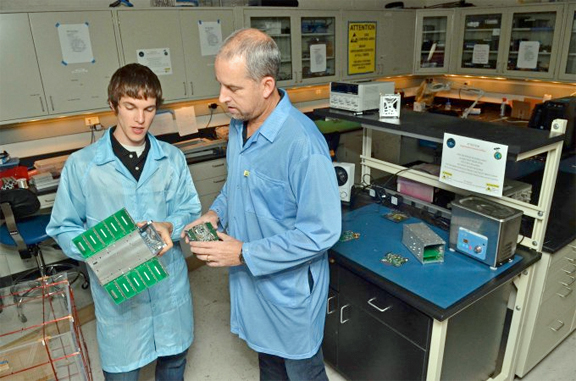[Satnews] A NASA-funded miniature satellite built by University of Colorado Boulder students will launched aboard the ULA's Atlas V push of Orbital ATK's Cygnus spacecraft on December 6, 2015—this is the start of a six-month-long mission to study solar flares and the powerful X-rays emitted by the sun.

Scott Palo, a professor in the Department of Aerospace Engineering Sciences at CU-Boulder, discusses the MinXSS CubeSat with first-year PhD student Colden Rouleau in the Satellite Technology Integration Lab.
Photo by Casey A.
The Miniature X-ray Solar Spectrometer (MinXSS) CubeSat, which was built by students in CU-Boulder’s Department of Aerospace Engineering (AES) in collaboration with researchers at the Laboratory for Atmospheric and Space Physics (LASP), will help shed light on how powerful electromagnetic emissions from the sun impact the Earth’s atmosphere, an effect known as space weather.
CubeSats are low-cost, short lifespan satellites built to take specific scientific observations and measurements. The MinXSS measures approximately 4 inches wide by 4 inches long by 12 inches high—about the size of a loaf of bread—and features cost-saving components such as an extendable tape measure that will serve as a radio antenna.

The University of Colorado Boulder Aerospace Engineering Sciences Department's MiniXSS CubeSat.
The MinXSS will be carried to the International Space Station (ISS) via a United Launch Alliance (ULA) Atlas V rocket. In November, the Centennial, Colorado-based ULA announced that CU-Boulder will receive a free CubeSat ride to space in 2017 as part of the aerospace company’s new initiative to make CubeSat launches more affordable and accessible to academic institutions nationwide.
Once delivered to the ISS, the MinXSS CubeSat will be deployed into space in January 2016 and operate for up to 12 months. CubeSat deployments from the ISS via a specially designed CubeSat deployer are made possible through a Space Act Agreement between NASA and NanoRacks LLC.
The MinXSS mission continues a successful tradition of CU-Boulder students designing and flying CubeSat missions, including the Colorado Student Space Weather Experiment, which launched in September 2012. More than 40 students worked on the MinXSS.
CU-Boulder’s AeroSpace Ventures partners with industry to accelerate discoveries in Earth and space science, broadly educate tomorrow’s highly skilled workforce, develop technologies that create new commercial opportunities and create collaborations that help industry grow. Founding corporate partners include Ball Aerospace, Blue Canyon Technologies, Braxton Technologies, Lockheed Martin, Sierra Nevada Corporation and Surrey Satellite Technology U.S.
To keep itself orientated toward the Sun correctly, the MinXSS will incorporate an XACT attitude determination and control system built by Blue Canyon Technologies, a Boulder, Colorado-based aerospace company founded by CU-Boulder graduate George Stafford.
“Understanding space weather is important because of the large number of navigation and communications systems that can be impacted,” said Tom Woods, associate director of LASP and principal investigator of MinXSS. “For example, communication disruptions by a space weather event can force airlines to change routes around Earth’s poles and impact GPS navigation used for myriad applications such as underwater oil drilling in the Gulf of Mexico and precision planting of seeds by specialized tractors.”
“In addition to educating the next-generation workforce of scientists and engineers, the MinXSS project exemplifies the mission of CU’s AeroSpace Ventures,” said Scott Palo, a professor in the Department of Aerospace Engineering Sciences at CU-Boulder. “AeroSpace Ventures is a collaboration among aerospace-related departments, institutes, centers and their industry partners to create knowledge and develop new technologies specifically focusing on unmanned and autonomous aircraft, small satellites and Earth and space sensors.”
"The MinXSS will be the first CubeSat to use the full XACT system and there are approximately 10 other CubeSats planning to launch in 2016 with an XACT onboard," said Matt Carton, an engineer at Blue Canyon Technologies and a CU-Boulder graduate.
Story by the University of Colorado, Boulder


